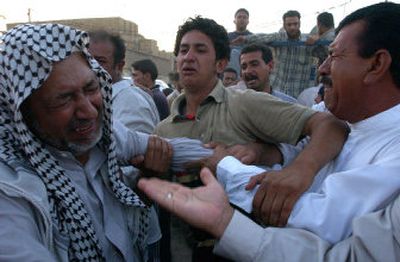Hundreds of Shiite Muslim pilgrims die

BAGHDAD, Iraq – Hundreds of Shiite Muslim pilgrims participating in an annual religious commemoration were crushed to death Wednesday as they crossed a bridge leading to a holy site in northern Baghdad, the stampede apparently triggered by fears of an insurgent attack and exacerbated by tight security restrictions.
The dead, most of them women, children and the elderly, numbered at least 750, with the Ministry of Health warning the toll could rise to 1,000 or more. It was the largest toll in any single deadly incident in Iraq since well before the 2003 U.S.-led invasion and was more than four times higher than that of the largest insurgent suicide bombing.
At least 300 more Iraqis were injured in the chaos along the four-lane roadway of the quarter-mile concrete-and-steel-girder bridge which spans the Tigris River. The victims were among the million Shiites from Iraq, Iran and elsewhere who cram into Baghdad’s Kadhimiya suburb once a year to commemorate the martyrdom of Imam Kadhem, an 8th-century Shiite saint.
“I died over and over again,” said Iraqi Army Col. Hassan Jabouri, who carried away many dead children. “It’s very hard to see a baby die in front of you.”
Many victims hailed from Sadr City, the vast eastern Baghdad slum where 2 million mostly poor Shiite Arabs live. As dusk settled, the streets of Sadr City turned into a vast funeral procession, with weeping men erecting mourning tents and bodies laid out in mosques to be washed in preparation for burial.
One woman arrived at the Saheb Zaman mosque in a taxi, crying and beating her face. She said she had lost her 9-month-old child in the crush and came to search for him among the corpses.
“One family lost four members,” said Fatah Sheik, an Iraqi politician from Sadr City who estimated that 600 of the dead came from his neighborhood. “We found a lady from Sadr City dead with her dead child lying on her chest. An old man took his two grandsons to the (Imam Kadhem) shrine (in Kadhimiya). They came back in three boxes.”
The exact cause of the melee remained unclear. Several mortar rounds had fallen on the crowds earlier in the day, killing at least six and making pilgrims and the many Iraqi soldiers and police officers on the scene skittish. Previous pilgrimages in Baghdad and shrines in Najaf and Karbala have been marred by suicide bombings – at least 181 people were killed in coordinated blasts at Shiite shrines in Karbala and Baghdad in March 2004, the largest such incident previously.
Some witnesses Wednesday said pilgrims panicked when they heard a rumor that a suicide bomber was among them. The crowd was boxed between high metal fences along the bridge and unable to move backward or forward because of checkpoints in front and oncoming pilgrims behind.
Others said additional mortar rounds had been fired at the pilgrims, causing the panic.
Some victims, desperate to avoid being trampled, jumped into the river’s muddy currents and drowned, witnesses and officials said. Most suffocated or were trampled to death as they tried to cross the bridge or escape the two-hour morning melee.
Survivors described macabre scenes of chaos. Ali Younis Hossein, a 32-year-old laborer sitting on a mattress in the hallways of Karkh Hospital, described being nearly choked to death by the crowd on the Aima Bridge and pointed to a bite-mark on his ankle from a victim underfoot.
“I had to step on them to get away,” he said.
Fellow pilgrims and security officials struggled to escape as well as evacuate the injured and dead, their faces and lips blue from suffocation. Baghdad’s many hospitals were overwhelmed with the grieving and dead.
After the chaos subsided, survivors gasped as they walked past mounds of colorful plastic slippers, the type worn by poor Iraqis, that were lying on the bridge along with tangled black women’s abayas and purses. Weeping women sorted through the piles, looking for the slippers of loved ones while scavengers searched the heaps for valuables.
Iraqi officials admitted that the tragedy was likely compounded by security measures put in place to prevent insurgents from crossing into Kadhimiya during the Shiite festivities. Kadhimiya is a mostly Shiite neighborhood, while the neighborhood across the river, Adhamiya, is mostly Sunni Arab, the minority sect that once controlled Iraq and has fueled the two-and-a-half-year surgency against U.S.-led forces and the Iraqi government.
Officials had worried a recent up-tick in sectarian violence could lead to full-fledged fighting between Sunnis and Shiites, who march through the streets of Adhamiya during the Imam Kadhem commemoration. Instead there were examples of Sunnis helping evacuate injured Shiite mourners.
Gen. Rawad Rumediam, a military commander at the bridge, said that 3-foot high concrete barriers put in place to prevent car bombs from entering likely contributed to the crush. Saddoun Dulaymi, Iraq’s defense minister, said the checkpoints at the bridge meant to search pedestrians for explosive devices may have slowed the flow of the crowd across the bridge and contributed to the disaster.
Brig. Gen. Abdul-Jalil Khalaf, military commander of Kadhemiya conceded in a television interview that the bridge “was not suitable for the use of pedestrians.”
Survivors, some wandering upon the bridge after the accident, blamed security officials for the deaths. Many criticized the government of Prime Minister Ibrahim Jafari.
“We asked the army troops to lift the concrete barriers from the road but they told us that the Americans put them in and they can’t move them,” said Jasim al-Kinani, who was among the many black-shirted young male volunteers helping with crowd control during the event.
The disaster is among the deadliest in recent Iraqi history. Comparable stampedes in Mecca have also killed hundreds of Muslim pilgrims. U.S. Ambassador Zalmay Khalilzad said that Washington was “prepared to offer whatever assistance we can to help the victims of this terrible tragedy.”